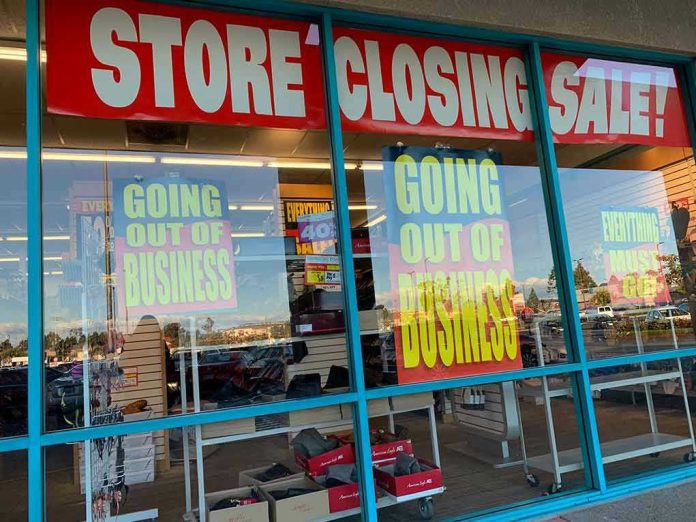
When a grocery chain that outlasted wars, recessions, and the rise of the internet vanishes overnight, the real story isn’t just about empty shelves—it’s about a nation’s broken promise to its most vulnerable.
Story Snapshot
- America’s largest discount grocery chain closed all 170+ stores abruptly in early 2025, catching employees and shoppers off guard.
- Low-income communities lost their last lifeline to affordable groceries, thrusting many into food insecurity and uncertainty.
- The closure is part of a larger epidemic: over 15,000 U.S. retail stores projected to shut down in 2025 alone.
- Industry experts blame runaway inflation, supply chain chaos, and failure to adapt as triggers for this retail collapse.
How a Trusted Grocer Became Collateral Damage
A grocery brand founded in the 1940s carved its niche by serving the overlooked—families whose budgets left no room for premium prices. Its business model was simple: deep discounts, minimal frills, and stores in neighborhoods where others wouldn’t go. By 2025, that approach, once its superpower, became its Achilles’ heel. As inflation escalated and shipping costs soared, the chain’s razor-thin margins evaporated. SNAP benefit cuts slashed customer spending, and online giants lured away even the most loyal shoppers. The chain’s leaders faced a reckoning: absorb unsustainable losses or shutter the doors.
The end came without warning. Employees who clocked in for their shifts found locked doors and blank windows. In many towns, the abruptness left communities reeling—no markdowns, no farewells, just a vanishing act. While a handful of locations offered hurried closing sales, most simply went dark. The sudden disappearance underscored a chilling new normal in American retail: legacy means nothing when dollars and cents don’t add up.
America’s New Food Deserts: When the Only Store in Town Goes Dark
For families in rural and inner-city neighborhoods, the fallout was immediate. The chain had often been the sole source of fresh produce, staples, and bulk bargains within miles. Its closure transformed thriving, if modest, retail hubs into food deserts overnight. Local food banks, already stretched thin, braced for a surge in demand. Social service agencies anticipated a spike in crisis calls. Landlords faced empty properties and lost rent, with little hope of finding new tenants as retail bloodletting accelerated nationwide. The ripple effects were economic, social, and deeply personal.
This wasn’t just the loss of a grocery store; it was the unraveling of a fragile ecosystem. As jobs disappeared and budgets tightened, communities found themselves squeezed between higher-priced chains and impersonal digital delivery services. For many, especially seniors and those without cars, these alternatives weren’t just inconvenient—they were inaccessible. The closure exposed a stark truth: America’s economic storms hit hardest where resilience is already in short supply.
Why This Closure Isn’t Just Another Retail Casualty
Industry analysts draw a straight line from this collapse to systemic forces buffeting the entire retail sector. Deborah Weinswig of Coresight Research points to a “perfect storm” of inflation, supply chain snarls, and lagging innovation. Companies that failed to modernize—digitizing logistics, investing in e-commerce, diversifying product lines—were left exposed. The pandemic had already weakened balance sheets; 2025’s relentless cost pressures finished the job. This chain’s demise is a case study in what happens when adaptation stalls.
The broader trend is unmistakable. Family Dollar, another discount stalwart, also began shuttering stores in 2025. Retail experts warn this year could see twice as many closures as 2024, with small-town and inner-city communities bearing the brunt. Policymakers now face mounting calls to step in: to boost food assistance, incentivize new grocers, or even rethink how America ensures access to basic necessities. The stakes go beyond commerce—they touch on public health, equity, and the promise of opportunity.
Who Pays the Price—And What Happens Next
Employees, blindsided by pink slips, face an uncertain job market. For customers, the loss is both economic and emotional—a blow to dignity and routine. Landlords and small businesses that depended on cross-traffic confront vacancy and decline. Local governments, already stretched, must fill the gap as food insecurity rises. The chain’s corporate leadership, insulated by golden parachutes and distant headquarters, has offered little solace beyond citing “unsustainable costs.”
The American grocery landscape is at a crossroads. As online behemoths and premium chains consolidate power, the fate of affordable, accessible food rests on whether communities, innovators, and policymakers can fill the void. Will new models emerge to serve those left behind, or will food deserts become a permanent fixture? The story of this 80-year-old chain’s abrupt exit is more than a cautionary tale—it’s a test of America’s ability to weather economic storms without abandoning those most in need.
Sources:
TheStreet: 70-year-old grocery store chain announces major closure















